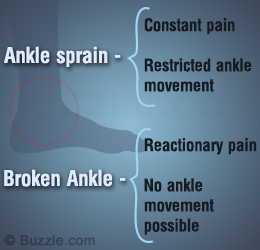Ankle sprains and fractures are common sports injuries. However, differentiating between the two is no easy task, as both injuries show common symptoms.

Did You Know?
Sprains do cause pain, but in most cases one can still move the ankle. However, a fracture completely impairs the mobility of ankle.
You are playing a soccer match and while you are dribbling the ball, an opponent is hell-bent on taking the ball from you. You try to dodge the opponent and in the process you hurt your ankle and collapse on the ground. You find that the ankle is swollen, bruised, and causing pain. The injury leaves you in doubt over whether the ankle is sprained or broken. So, how do you recognize whether the injury is a sprain or a fracture?
Well, this Buzzle article gives you some tips to differentiate between the two.
An ankle sprain damages the ligament, a bundle of thick fibrous tissue that does the job of joining one bone to another to form a joint. An ankle fracture resulting from a blunt trauma breaks the bone. In either case, symptoms are more or less the same, yet a close observation may help you to assess the injury.
Differences Between an Ankle Sprain and Fracture
► Weight
In both cases, it is difficult to bear weight on the injured area, yet there is difference. Although facing difficulty while walking is a given in either an ankle sprain or fracture, the intensity of the pain varies. For instance, a sprained ankle hurts, yet the person may be able to walk with a limp. Most people, after getting a sprain, are able to put weight on the ankle, though they are seen limping. However, in case of a fracture, even an attempt to walk causes excruciating pain. A broken ankle is unable to bear any weight, and hence walking even a step or two is next to impossible.
► Pain
The frequency of pain is another indicator for the type of injury. A broken ankle is typically marked by constant, debilitating pain, despite keeping the ankle immobile. However, a sprained ankle usually hurts only when some amount of weight is put on it. Taking rest can also contribute immensely to alleviate discomfort associated with ankle sprain.
► Site of Discomfort
In case of a fracture, severe pain lingers over the ankle bone. As aforementioned, a sprain damages the ligament, but the bone remains intact. No wonder, a sprain is also referred to as a soft tissue injury.
► Swelling
Swelling is also common in either of the injuries, but the severity differs. Usually, a sprain causes mild to moderate swelling, but a fracture, in most cases, triggers severe swelling. A bump may also form, indicating that the bone has bulged out of the skin. A fracture displaces the joint from its normal position. Such a kind of deformity, where the bone pokes out of the skin, is not present in a sprained ankle.
► Unusual Sensation
Numbness or a tingling sensation in the ankle after a fracture is common. However, people with a sprained ankle generally do not experience these unusual sensations.
► Sound
A popping sound during the injury may indicate an ankle sprain, but a cracking sound at the time of injury may suggest a fracture.
► Diagnosis
For proper diagnosis, it is essential to undergo an X-ray of the injured ankle. In some cases, an X-ray may fail to detect an existing fracture, which can lead to incorrect diagnosis. A better option to detect a fracture is to undergo a bone scan. After confirmation, your health care provider may recommend a CT or a MRI scan to evaluate the amount of damage caused by the fracture.
In either case, be it a fracture or sprain, one should not ignore the condition and take the precautionary steps and the treatment necessary before things go out of control. Dilly-dallying treatment can lead to chronic pain and swelling that may last for months.
Disclaimer: The information provided in this article is solely for educating the reader. It is not intended to be a substitute for the advice of a medical expert.


